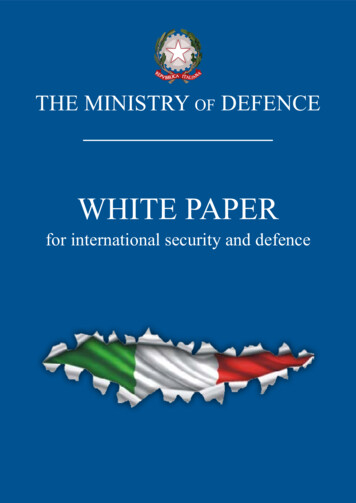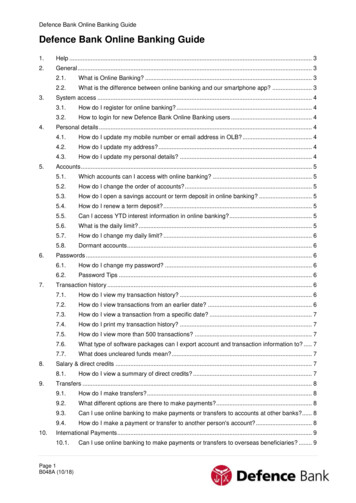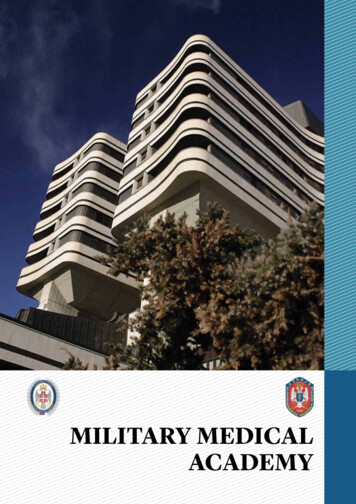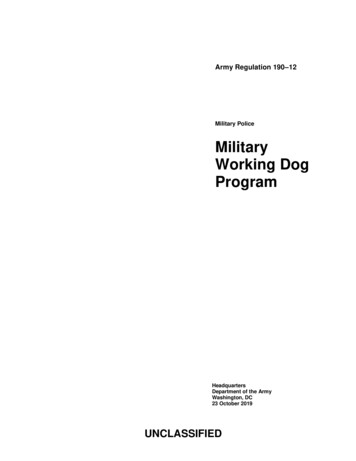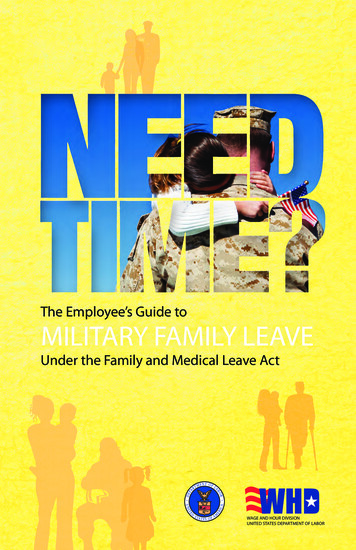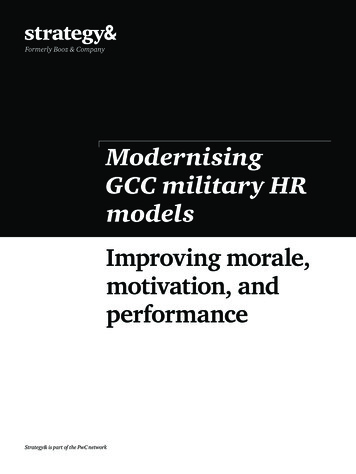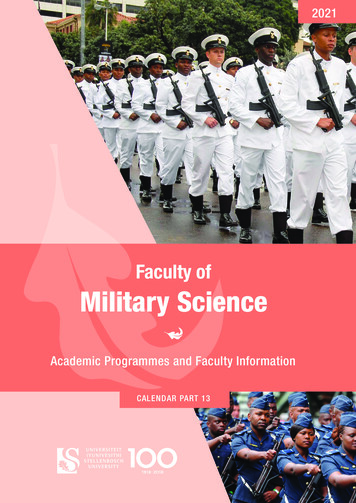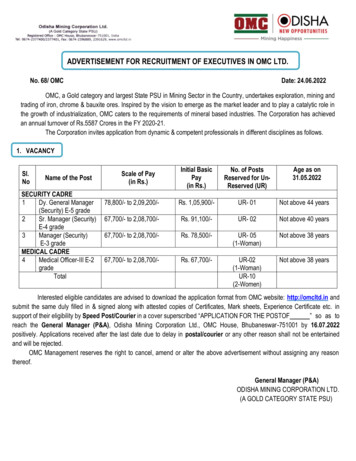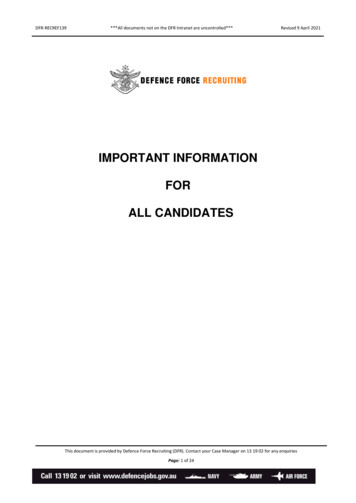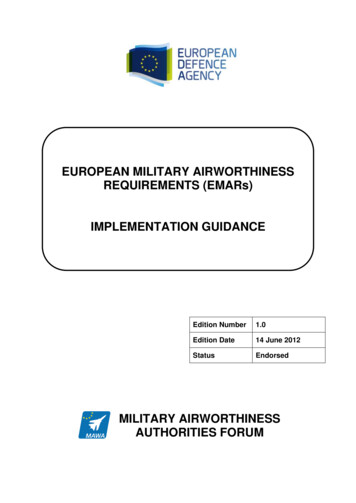
Transcription
EUROPEAN MILITARY AIRWORTHINESSREQUIREMENTS (EMARs)IMPLEMENTATION GUIDANCEEdition Number1.0Edition Date14 June 2012StatusEndorsedMILITARY AIRWORTHINESSAUTHORITIES FORUM
EMAR IMPLEMENTATION GUIDANCEDOCUMENT CONTROLDOCUMENT APPROVALThe following table identifies the persons who have approved this documentEditionNo:MAWA Forum/TFAuthorised byDATEPreparedbyEDA-1 June 2012EndorsedbyMAWA ForumF15MAWA Forum Chairman14 June 2012Ed 1.0Edition Number : 1.0Edition Date : 14 Jun 12Status: EndorsedPage 2/35
EMAR IMPLEMENTATION GUIDANCEDOCUMENT CHANGE RECORDEditionNumber1.0EditionDateStatusReason for change(detailed)Sections or pagesaffectedInitial issueAll14 June 2012 EndorsedEDITIONEdition will have the following template: Edition X.YThe value of X will change after a major modification of the documentThe value of Y will change after a minor modification of the documentNOTE:Edition Number : 1.0Edition Date : 14 Jun 12Status: EndorsedPage 3/35
EMAR IMPLEMENTATION GUIDANCETABLE OF CONTENTSScope of Use .51.INTRODUCTION .62.BACKGROUND .63.IDENTIFICATION OF THE NEED.74.SCOPE .75.EMAR IMPLEMENTATION ISSUES .85.15.25.35.45.55.6LEGAL/REGULATORY ISSUES. 9ORGANISATIONAL . 13COMMUNICATION/MARKETING . 19RESOURCE. 22PEOPLE-ISSUES . 24OTHER-ISSUES. 266.KEY IMPLEMENTATION PRINCIPLES . 297.FURTHER WORK . 31ANNEXES . 31Edition Number : 1.0Edition Date : 14 Jun 12Status: EndorsedPage 4/35
EMAR IMPLEMENTATION GUIDANCEScope of UseThis EMAR Implementation Guidance document has been developed to provide theEDA pMS with guidance on a number of approaches that could be used to implementthe EMARs. The contents have been based upon the experiences of pMS that havealready implemented “EMAR like” regulations that are based upon the EASAregulations.The contents of this document in no way compel any pMS to adopt any of theapproaches detailed within it; rather it should be considered to be a mechanism to gainbenefit from the lessons learnt from other pMS. This document should be considered tobe a „living‟ document that should be periodically updated to reflect new experiences thathave been gained by pMS in implementing the EMARs that will benefit other pMS.The initial issue of this document has been written prior to the full development of EMADR and prior to the resolution of a number of key principles including Recognition. sdocument.Edition Number : 1.0Edition Date : 14 Jun 12Status: EndorsedPage 5/35
EMAR IMPLEMENTATION GUIDANCE1. INTRODUCTIONWith the publication in January 2011 of the first European Military AirworthinessRequirement (EMAR 145), one of a suite of European Military AirworthinessRequirements, the Military Airworthiness Authorities (MAWA) Forum requested the EDAto facilitate a workshop where the challenges that are being faced by pMS inimplementing these Requirements into their own national airworthiness regulations couldbe discussed and possible solutions identified.The Netherlands kindly volunteered to host the event which was held on 28 and 29February 2012 at Woensdrecht Air Force Base. 30 attendees representing 12 pMS, theEuropean Air Transport Command, the EDA and industry association representativesfrom Aerospace and Defence (ASD) came together with the goal of developing an„EMAR Implementation Toolset‟ that would assist pMS to identify and use differentmethods to resolve common issues. As part of the workshop schedule, a visit to theaircraft maintenance facilities and maintenance training school at Woensdrecht wasincluded. Both facilities are compliant with the NL‟s „Military Airworthiness Regulations‟(which are very similar to the EMARs), so this allowed workshop attendees tounderstand the challenges and practical solutions encountered by the NL inimplementing their regulations and to visualize how this would look in practice.2. BACKGROUNDOn 10th November 2008 the EDA Steering Board in NADs formation tasked the EDA towork on the establishment of an EU-wide Forum for Military Airworthiness Authorities(MAWA), to enable initial discussions on harmonizing military airworthiness. An Ad-HocProject Group on Military Airworthiness Harmonisation was established and prepared anairworthiness roadmap in preparation for the establishment of the MAWA Forum.The initial activities of the MAWA Forum focused on charting existing documents, rulesand regulations and identify both commonalities that could form the basis for a commonEU approach, together with the identification of shortfalls that are currently notaddressed in comparison to the acknowledged civil approach. The goals of this MAWAForum were then to recommend the following for adoption by pMS Military AirworthinessAuthorities:a.Common regulatory framework;b.Common certification processes;c.Common approach to organisational approvals;Edition Number : 1.0Edition Date : 14 Jun 12Status: EndorsedPage 6/35
EMAR IMPLEMENTATION GUIDANCEd.Common certification/design codes;e.Common approach to preservation of airworthiness;f.Arrangements for mutual recognition;g.The formation of a European Military Joint Airworthiness AuthoritiesOrganisation.On 17th November 2009, the EDA Steering Board in Defence Ministers‟ formationdeclared their political support for national airworthiness authorities to develop andimplement the European Military Airworthiness Requirements (EMARs) in line with theendorsed roadmap. The MAWA Forum established a number of Task Forces, consistingof SMEs from the pMS that had specific expertise in the appropriate airworthiness areas,to develop the EMARs. At the 9th MAWA Forum on 19th January 2011, EMAR 145 wasapproved.On 24th March 2011 the NADs SB requested a report on the pMS‟s implementationstatus of EMAR 145. The EDA coordinated a report on behalf of the MAWA Forum thatdetailed the information requested by the NADs. Whilst carrying out this activity itbecame apparent that pMS could gain significant benefit from an EMAR workshop, atwhich a wide variety of EMAR Implementation issues could be identified, discussed andresolved. The workshop was held on 28th - 29th February 2012 at Woensdrecht Air ForceBase in the Netherlands.3. IDENTIFICATION OF THE NEEDAt the 12th MAWA Forum on 22 September 2011 the possibility of holding a dedicatedMAWA Workshop that would enable pMS to exchange their views and analyses on theimplementation of the EMARs was discussed. The workshop would also enable the EDAto provide a clearer picture of the status of EMAR 145 implementation when providingfeedback to the NADs SB. The concept was supported in principle by the MAWA Forum,who requested EDA to draft a proposed „Planning Document‟ for approval. At the 13thMAWA Forum on 26th January 2012 the topic was further discussed and the MAWAForum supported holding an „EMAR Implementation Workshop‟.4. SCOPEThe MAWA Forum approved the Top-Level goal of the Workshop as being to “Establisha deeper understanding of the challenges facing pMS when implementing the EMARS,and the development of an „implementation-toolset‟ of solutions to overcome thesechallenges”.In addition, the following further secondary goals were accepted:Edition Number : 1.0Edition Date : 14 Jun 12Status: EndorsedPage 7/35
EMAR IMPLEMENTATION GUIDANCEa.Gaining a better understanding of the pMS‟s EMAR implementationchallenges that have been experienced (past and present)b.The Identification of common barriers to national EMAR implementation(e.g. legal, duty holders, organisational structures, national army/navy/airforce/civilian structural differences etc.).c.Gaining a better appreciation of the dependencies between the EMARsand their timings (e.g. production of „Acceptable Means of Compliance‟, thedevelopment of EMAR 147 and 66 etc.). This topic could also include anunderstanding of whether EMARs can be implemented individually, or as a wholesuite.d.What are the next steps for EMAR implementation? (To include thedevelopment of a common vision/direction of where the MAWA Forum would liketo go and an understanding the difference between „implementation‟ and„adoption‟.)e.The identification of agreed fundamental principles/agreements for EMARimplementation (e.g. core requirements). Is there an agreed understanding of thereason for change? What does implemented/adopted actually „look like‟? What isthe end-game that nations should be aiming for?f.Gaining a better understanding of the linkage between EMARimplementation and Recognition (i.e. does a pMS have to implement all of theEMARs for Recognition?)5. EMAR IMPLEMENTATION ISSUESUsing the methodology outlined in Annex A, issues that were identified during an initial„brainstorming‟ activity were analysed by the Workshop Attendees and „categorised‟ intoone of 6 main topic er-Issues;Edition Number : 1.0Edition Date : 14 Jun 12Status: EndorsedPage 8/35
EMAR IMPLEMENTATION GUIDANCEThese issues were then reviewed and „grouped‟ where appropriate to identify topics thathad been raised several times by different attendees. Solutions that had either beensuccessfully utilized by pMS, or could be considered for use, were then identified andcaptured. The aim was to produce a selection of considerations from which thoseresponsible for implementing the EMARs within pMS could select solutions that wouldbe most appropriate for the organisational structure within their nation. Individual issueswere also captured, with possible solutions mapped to these where appropriate.5.1LEGAL/REGULATORY ISSUESIssue: The need to develop a national airworthiness framework and establish theMilitary Airworthiness Authority’s (MAA) legal basis within it (particularlyindependence).It was identified that prior to EMAR implementation, a pMS should establish a nationalairworthiness framework or structure within which the EMARs could be included. Inaddition, an entity or organisation within the pMS should be made responsible for thedifferent aspects of airworthiness („continued‟ and „continuing‟). Ideally this should beachieved by establishing a Military Airworthiness Authority (MAA) as a single focal pointfor military airworthiness. The need for the MAA to have the appropriate level ofauthority, independence and ability to act was also discussed.Possible solutions:a.If a nation has no pre-existing MAA, then consideration could be given tostarting within an existing independent entity/organisation (e.g. from an existingAir Force structure or equivalent).b.The level of „Independence‟ for the authority must be considered and willbe determined based upon the pMS‟s organizational structure. It is important thatthe MAA can demonstrate „independence‟ in order to ensure that airworthinessdecisions are made free from any other factors that could influence them.c.The size of an MAA will be dependent on a number of factors including thefollowing:i.Aircraft fleet size;ii.Number of different aircraft types;iii.Number of organisations that require approval;iv.Existing organisational structure;v.Coverage of different service e.g. Army, Navy, Air Force;Edition Number : 1.0Edition Date : 14 Jun 12Status: EndorsedPage 9/35
EMAR IMPLEMENTATION GUIDANCEd.To effectively establish an MAA, a pMS may require a national law toprovide the required level of authority directly from government (nations will havea law authorizing their CAA).e.The development of an approved national „Basic Framework Document‟may help to define the responsibilities and structure of a nation‟s militaryairworthiness organisation.f.The entity (or MAA) that is responsible for military airworthiness shouldestablish a formal relationship with (any appropriate) Civilian Equivalentorganisations (i.e. national Civil Aviation Authority) in order to clarify the scopeand boundaries of responsibilities between the 2 organisations.i.Relationships may have to be established by national law (withboundaries clearly established).ii.Relationship with Civil Authorities may have to be on a „case-by-case‟basis according to the needs of specific programmes (e.g. C27,A400M, NH-90 etc.).g.The roles and responsibilities of the MAA (or other entity responsible fornational military airworthiness) must be clearly defined. These should be agreedwith all affected stakeholders. Also, the ability to impose corrective actions mustalso be clear (e.g. the ability to withdraw a Type Certificate, recommendrestrictions etc.). Other factors to consider are that:i.The MAA must be rigid enough to ensure airworthiness is maintainedbut also flexible enough to ensure the delivery of operational capability.ii.The level of seniority of the head of the MAA may be a factor whentrying to impose corrective actions.iii.The responsibilities of the operator should also be defined in order toensure that there are no gaps between the MAA and the operator.h.It may be necessary to implement the EMARs into National Law (therelationship between a nation‟s Aviation Law and their „Airworthiness Regulationsshould be clarified first). Other factors to consider regarding the need toimplement EMARs into national law are:i. If it is possible for the EMARs to be implemented directly (adopted) intoNational Regulations/Law, or is an alternative process required.ii. If it is possible to implement the EMARs before the AMC/GM isproduced. If this is the case, can other AMC/GM (e.g. EASA) be usedin the meantime?Edition Number : 1.0Edition Date : 14 Jun 12Status: EndorsedPage 10/35
EMAR IMPLEMENTATION GUIDANCEiii. Consideration must be given to what language will need to be used fornational regulation. (English language shall be used for Recognitionpurposes in accordance with the Basic Framework Document but ifnational regulations require translation, then the MAA will have toensure that they meet this requirement.)iv. When implementing a new national regulation for the EMARs,consideration should be given to transitional provisions/arrangements.Particular care should be given to the ability to combine existingregulatory systems with new regulatory systems (e.g. personnel„licensing‟ schemes and the possible use of „grandfather rights‟).v. For clarity of understanding, a single basic regulation, applicable to allorganisations (military and contractor) would be preferred and wouldprovide greater interoperability. This would also allow „standardisation‟of regulatory forms/documents in use in the military and industry.i.The key national decision is whether to „implement/adopt‟ the EMARswithout change into national regulations, or instead to map/assess a nation‟sexisting national law and regulations to identify and declare „deltas „and shortfallsor to be able to declare „full compliance‟. Considerations include:i.The final goal according to the ministerial decisions should be for a“common approach” and the adoption of the EMARs.ii.Commonality between nations and the ability to easily carry out„recognition‟ will be reduced if the EMARs are not adopted, with EMARcompliance being declared instead.Awareness that during any transitional provisions where differencesexist between national regulations and the EMARs, these may causeproblems for international cooperation and recognition.iii.j.The responsibilities of the operators/operating units within the new EMARregulatory framework need to be clearly defined, agreed and communicated withstakeholders. The responsibilities and competence requirements at all levelswithin the organisation (for maintenance personnel and management) must beclarified.k.As national airworthiness regulation is adapted to implement the EMARs, itis important that national airworthiness processes and procedures are aligned tocomply with the new regulations.l.The retention of control over national sovereignty shall be stronglymaintained. The military airworthiness regulatory structure/framework and thearrangements for the MAA should enable nations to make sovereign decisionsthat are in their national interest.Edition Number : 1.0Edition Date : 14 Jun 12Status: EndorsedPage 11/35
EMAR IMPLEMENTATION GUIDANCEIssue: It is important to find an arrangement for who will be the Military TypeCertificate Holder (MTCH) for the aircraft types that are operated, especially formultinational projects.The role of the Military Type Certificate Holder (MTCH) is considered pivotal in ensuringthat the Continued Airworthiness of the military aircraft type can be assured andcorrectly managed throughout the service life of the aircraft. The MTCH is responsiblefor certain aspects of the airworthiness of an aircraft‟s type design (not individual aircraft)and shall be “competent” to carry out these functions. In cases where the MTCH is notwithin a MoD Organisation, then the organisation/individual carrying out these functionsshould be audited, assessed and approved. In some pMS it may be difficult to provide anon-MoD organisation to have responsibility or authority to act for some airworthinessmatters. In this case, alternative arrangements will need to be considered.Possible solutions:a.In order to reduce duplication of effort it may be possible to achieve anexchange of Type Certificates (including Military Type Certificates) with anothernation. This can only be accomplished if “Recognition” is achieved between thepMS involved.b.Consideration could be given to the inclusion of the requirement forindustry to be the MTCH within a contract to deal with the Type Certificationprocess and other Continued (Design) airworthiness issues.c.In multi-national programmes it is important to identify who will be theMTCH early in the Design and Development phase in order to reduce the risk ofprogramme delays caused by uncertainty. If a partner nation is unable to allow anon-MoD organisation to be the MTCH then this should be indicated early on inthe programme. Possible solutions could include allowing industry to carry outcertain design functions but retaining control and decision making with the MoDorganisation.d.The airworthiness regulatory structure should be flexible enough to coverdifferent solutions where compromises are needed for multi-nationalprogrammes.Issue: Changes to existing contracts with industry.The implementation of the EMARs into national regulations may require a modificationor change to existing contracts with industry. This may or may not introduce additionalcosts in the short-term. Industry must also be willing to accept the changes, togetherwith any associated increases in responsibility.Possible solutions:Edition Number : 1.0Edition Date : 14 Jun 12Status: EndorsedPage 12/35
EMAR IMPLEMENTATION GUIDANCEa.A firm stance could be that a precondition for any contract award withindustry would be to have appropriate approvals in line with the EMARsb.Industry‟s organisational approvals (e.g. EMAR 21, EMAR 145 etc.) couldbe issued as part of the contract award/contract renewal process. This wouldreduce the costs involved with renegotiating a contract and would incentiviseindustry to gain approval.c.The negative aspect of waiting for a natural break in a contract would bethe delay in implementing the EMARs due to the fact that existing contracts maybe for a long period.5.2ORGANISATIONALIssue: Introduction of Continuing Airworthiness Management Organisations(CAMOs) (including Airworthiness Review Certificates and the baselining of anaircraft’s Certificate of Airworthiness)The implementation of EMAR 145 and EMAR M (when it is approved) require theestablishment of a Continuing Airworthiness Management Organisation (CAMO) thatwould be responsible for the continuing airworthiness of the aircraft allocated to it. (Itshould be noted that there is some overlap between the responsibilities of the CAMOand those responsibilities traditionally associated with the entity responsible for thecontinued airworthiness of the Type Design.) This is made even more difficult due to thefact that the responsibilities of the CAMO are within the aircraft operator‟sresponsibilities.The implementation of EMAR 21 and EMAR M (when it is approved) will require eachaircraft to have a valid Certificate of Airworthiness (CoA) confirming that each individualtail-number conforms to the approved aircraft design and configuration. The physicalcondition of each individual aircraft will be reviewed at a set periodicity to ensure that it isstill in conformity and an Airworthiness Review Certificate (ARC) will be issued thatrevalidates the CoA.Possible solutions:a.The positioning of the CAMO within the organisational structure (at theright level) is essential. Responsibilities must be clearly split between the„operator‟ (who is responsible for managing the Continuing Airworthiness) and the„maintenance‟ organisation.b.The physical proximity of the CAMO to the aircraft for which they areresponsible and the EMAR-145 maintenance organisation needs to be assessed.It is possible for the CAMO to be remote from the maintenance organisation butfor efficiency reasons co-location could be considered (whilst also maintaining therequired level of segregation and independence from the maintenanceorganisation).Edition Number : 1.0Edition Date : 14 Jun 12Status: EndorsedPage 13/35
EMAR IMPLEMENTATION GUIDANCEc.The Continuing Airworthiness Manager‟s responsibilities (as the head ofthe CAMO) must be clearly defined taking into account:i.The need to properly define an acceptable level/rank for thisresponsibility.ii.The need for the individual to be able to act/impose any requiredchanges to ensure the continuing airworthiness of the aircraft for whichthey are responsible.d.It may be useful to be prescriptive within national regulations when definingthe most appropriate CAMO structure. This may avoid misinterpretation of theregulations by those implementing them. However the regulation should beflexible enough to consider cases where it may not be possible to maintain a rigidstructure. Factors to consider when determining the organisational structure ofthe CAMO are:i.The number of different aircraft types that they are responsible for andalso the location of these aircraft.ii.Multiple CAMOs (on different bases) for single aircraft types (with alead CAMO/Main Operating Base) where the type is operated out ofmore than one airbase.iii.A single CAMO on a base for multiple aircraft types (where differenttypes are operated at the same air station).iv.Single CAMOs on a base with a single aircraft type, where a CAMO isresponsible for a single type only.v.For aircraft on operations, consideration of the use of a „Sub-CAMO‟ for„in-theatre aircraft (how this works should be clearly detailed in theContinuing Airworthiness Management Exposition (CAME).vi.A „Civil‟ CAMO (e.g. an EASA approved CAMO) could be overseen bya “crown/state-servant” from the MoD for aircraft fleets that are eithercivil derivative/or purely civil variants.vii.Outsourcing of CAMO activities is possible but control should beretained within the MoD organisation (the MoD is still responsible forthe continuing airworthiness of the aircraft that they operate).e.Carrying out the first Airworthiness Review Certificate (ARC) on eachaircraft will be difficult and challenging. An MAA may need to consider a transitionplan until all aircraft have completed their first ARC. Factors to consider include:Edition Number : 1.0Edition Date : 14 Jun 12Status: EndorsedPage 14/35
EMAR IMPLEMENTATION GUIDANCEi.There is a need for each individual aircraft to remain within a„controlled environment‟ to avoid having to carry out the physicalreview of the aircraft annually (this can be extended to 3 years if anaircraft remains within a „controlled environment‟).ii.A standard procedure/process should be developed for ARCinspections so that everyone involved in the process knows what isrequired, enabling appropriate preparations to be carried out. This alsoallows the process to be repeatable by others.iii.The initial ARC assesses the conformity of each aircraft against its„type definition‟. This can be challenging for legacy or historic aircraftwhere the type certification basis or type definition is not known. Thismay require:a)An assessment and identification of mandatorymodifications/changes in order to establish if they have beenincorporated onto the aircraft.b)Full access to historic data in order to determine theapproved configuration of the aircraft.c)For older aircraft, a pragmatic approach („As Low AsReasonably Practicable‟) may be necessary, since not allairworthiness data may be accessible or even still exist. Riskassessment and management of any gaps that are identifiedwill be required.iv.ARC inspectors are nominated by the CAMO but must be approved bythe MAA. This may create a resource issue and may be the limitingfactor for the speed that the aircraft fleet can be reviewed and issuedwith a CoA and an ARC.v.It may be possible to schedule the initial ARC at the same time as adeep maintenance activity, where access to each aircraft to assess theembodiment of modifications etc. will be easier and would not interruptthe operating schedule.f.Some nations may have 3 (or more) services (Army, Navy, and Air Force)that all currently manage continuing airworthiness differently. The introduction ofa CAMO, CoA and ARC will need to be coordinated and harmonised throughoutthe different services. This would be made easier with the establishment of anational MAA.g.The linkages to, and the role of, a multi-national OpCon body in theairworthiness regulated environment needs to be established. Clearresponsibilities of each must be understood.Edition Number : 1.0Edition Date : 14 Jun 12Status: EndorsedPage 15/35
EMAR IMPLEMENTATION GUIDANCEIssue:Organisational changes are necessary to implement a new regulatorystructure.The implementation of the EMARs may require organisational changes in order tocomply with a new regulatory structure. These organisational transformations may taketime to plan and put into effect and there may be resistance to change within theorganisation.Possible solutions:a.The successful introduction and implementation of the EMARs requirestop-level management endorsement of the required changes, including thefollowing factors:i. Understanding the philosophy that underpins any new regulations and whythey are being introduced.ii. There is an accepted need to change current processes to enable greateralignment between nations. Possible tools for change could be:a)Continuous improvement mechanisms.b)Lean Management techniques.iii. Change in the military culture from „Can-Do‟ to „Safe-Way‟ may berequired.b.Once established, the MAA (or other entity responsible for airworthiness)should be “legally competent” and should also be an Independent organization (orat the very least to be able to demonstrate independent decision making). It isparticularly important that any MAA approved documents (MTC, DOA, POA, -145147 & -M organisational approvals, maintenance personnel licences etc.) shouldbe able to be recognised by other nations. Other factors include:i.The MAA (or other entity responsible for airworthiness) should be free fromcommercial, programme/procurement and operational pressures. Inaddition it should ensure:a)That an appropriate linkage is made with Armamentsprogrammes that are responsible for the delivery/support ofequipment.b)The adequate and appropriate involvement of Project Teamexperts, whilst also being able to show clear independence forairworthiness Decisions.Edition Number : 1.0Edition Date : 14 Jun 12Status: EndorsedPage 16/35
EMAR IMPLEMENTATION GUIDANCEc)That handledThe capacity and ability of the MAA to carry out the requiredworkload/responsibilities,including approval activitiesandthemanagement of a licensing scheme, needs to be considered beforeimplementing any new airworthiness regulation for the EMARs. In addition:a)It may be possible to outsource some oversight and auditingactivities, noting that independent monitoring of organisations shouldbe finally approved by the MAA.iii.Dual responsibilities (i.e. regulatory with operational/commercial) should beavoided for personnel within the MAA.iv.Having all elements of the MAA co-located (all in one place) has proved tobe ver
Forum supported holding an „EMAR Implementation Workshop‟. 4. SCOPE The MAWA Forum approved the Top-Level goal of the Workshop as being to "Establish a deeper understanding of the challenges facing pMS when implementing the EMARS, and the development of an „implementation-toolset‟ of solutions to overcome these challenges".
